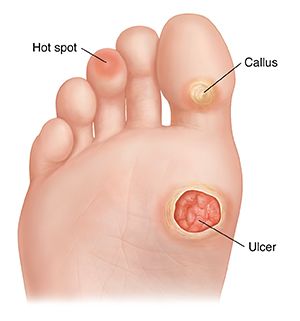What Are Pressure Injuries of the Foot?
Force or friction against the bottom of your foot causes the skin to thicken. This thick skin is called a callus. If the skin keeps thickening, the callus presses up into the foot. A callus pressing into the foot may harm healthy tissue. This can cause a pressure injury (ulcer). As healthy skin dies, a pressure injury forms. Pressure injuries may change from hot spots to infected wounds very quickly.
But you may not notice the pain if you have nerve damage (neuropathy). This health problem limits the feeling in your feet. Diabetes is a common cause of neuropathy.

Hot spots
Red hot spots on the skin are signs of pressure or friction. They are a warning to take care of your feet. A hot spot is likely to blister if the pressure is not eased. Left untreated, a blister can turn into an open wound, a corn, or a callus. A corn is thickened skin on top of the foot. Surgery to fix bunions, claw toes, or hammertoes may ease pressure on hot spots and pressure injuries. Knee walkers can also let you to get around without putting pressure on the affected foot. Special therapeutic shoes can also help ease pressure.
Pressure injuries
If a corn or callus presses into the foot, it destroys inner layers of skin and fat. Cracks and sores may form. These open wounds are pressure injuries. They can let infection enter the body. In some cases, dead skin, such as a corn or callus, may cover an open wound. This can make it harder to see.
Infected pressure injuries
If bacteria enter the pressure injury, infection sets in. This causes healthier tissue to die. The infected pressure injury may start to drain. The discharge may be white, yellow, or green. Some infected pressure injuries bleed or have a bad odor. The skin around an infected pressure injury may become red or warm. Call your healthcare provider right away if you think you have an infected pressure injury.
You will need follow-up visits to your healthcare provider even if your pressure injury goes away. This is because the affected area stays weak. There may be underlying weaknesses that need to be treated, such as poor circulation. The chance of a new pressure injury is high. Check your feet each day for signs of pressure injuries. Use a mirror to check the bottom of your feet. Take action if you see changes.